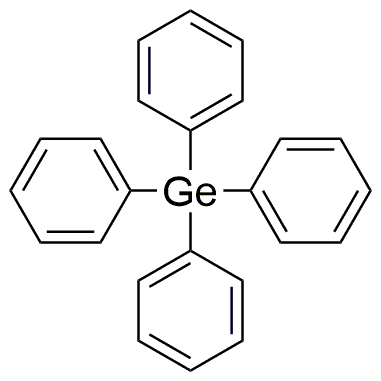Tetraphenylgermane is widely utilized in research focused on:
- Semiconductor Industry: This compound is used in the production of germanium-based semiconductors, which are essential for high-performance electronic devices.
- Organic Synthesis: It serves as a reagent in organic chemistry, particularly in the synthesis of organometallic compounds, allowing chemists to create complex molecular structures efficiently.
- Material Science: Tetraphenylgermane is explored for its potential in developing new materials with unique electrical properties, beneficial for advanced applications in nanotechnology.
- Pharmaceutical Research: Researchers investigate its properties for potential use in drug delivery systems, leveraging its ability to interact with biological molecules.
- Environmental Applications: Its role in catalysis is being studied for environmental remediation processes, particularly in breaking down pollutants effectively.
General Information
Properties
Safety and Regulations
Applications
Tetraphenylgermane is widely utilized in research focused on:
- Semiconductor Industry: This compound is used in the production of germanium-based semiconductors, which are essential for high-performance electronic devices.
- Organic Synthesis: It serves as a reagent in organic chemistry, particularly in the synthesis of organometallic compounds, allowing chemists to create complex molecular structures efficiently.
- Material Science: Tetraphenylgermane is explored for its potential in developing new materials with unique electrical properties, beneficial for advanced applications in nanotechnology.
- Pharmaceutical Research: Researchers investigate its properties for potential use in drug delivery systems, leveraging its ability to interact with biological molecules.
- Environmental Applications: Its role in catalysis is being studied for environmental remediation processes, particularly in breaking down pollutants effectively.
Documents
Safety Data Sheets (SDS)
The SDS provides comprehensive safety information on handling, storage, and disposal of the product.
Product Specification (PS)
The PS provides a comprehensive breakdown of the product’s properties, including chemical composition, physical state, purity, and storage requirements. It also details acceptable quality ranges and the product's intended applications.
Certificates of Analysis (COA)
Search for Certificates of Analysis (COA) by entering the products Lot Number. Lot and Batch Numbers can be found on a product’s label following the words ‘Lot’ or ‘Batch’.
*Catalog Number
*Lot Number
Certificates Of Origin (COO)
This COO confirms the country where the product was manufactured, and also details the materials and components used in it and whether it is derived from natural, synthetic, or other specific sources. This certificate may be required for customs, trade, and regulatory compliance.
*Catalog Number
*Lot Number
Safety Data Sheets (SDS)
The SDS provides comprehensive safety information on handling, storage, and disposal of the product.
DownloadProduct Specification (PS)
The PS provides a comprehensive breakdown of the product’s properties, including chemical composition, physical state, purity, and storage requirements. It also details acceptable quality ranges and the product's intended applications.
DownloadCertificates of Analysis (COA)
Search for Certificates of Analysis (COA) by entering the products Lot Number. Lot and Batch Numbers can be found on a product’s label following the words ‘Lot’ or ‘Batch’.
*Catalog Number
*Lot Number
Certificates Of Origin (COO)
This COO confirms the country where the product was manufactured, and also details the materials and components used in it and whether it is derived from natural, synthetic, or other specific sources. This certificate may be required for customs, trade, and regulatory compliance.


